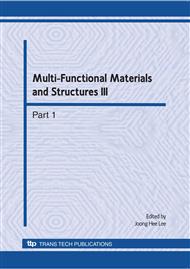p.3
p.7
p.11
p.15
p.19
p.23
p.27
p.35
Advanced Conductive Composite Materials for Spacecraft Application
Abstract:
In this study, thermal responses of advanced fiber/epoxy matrix composite materials are considered for spacecraft thermal design. These thermal responses are important, because the localized thermal behavior from applied heat loads can induce thermal stresses, which can lead to functional failure of the spacecraft system. Since most of polymer matrices exhibit relatively poor thermal conductivity, the composite materials have been widely considered only for structural application and little for thermal application. However, recently pitch-based high performance carbon fiber becomes available and this fiber shows high thermal conductivity. Because of this combination of low CTE and high thermal conductivity, continuous carbon fiber composites make them suitable for thermal management of spacecraft. The advanced composite material is composed of a continuous high modulus pitch based fiber (YS90A) and DGEBA epoxy resin(RS3232). It was demonstrated that advanced composite material satisfied thermal requirement for a lightweight thermal radiator for heat rejection of communication satellite.
Info:
Periodical:
Pages:
7-10
Citation:
Online since:
August 2010
Authors:
Price:
Сopyright:
© 2010 Trans Tech Publications Ltd. All Rights Reserved
Share:
Citation:


